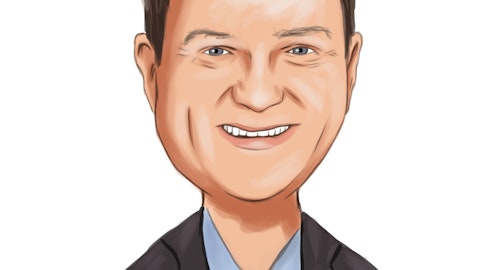The way we work on Cimetrix is we sell a design kit, software design kit, development kit that the customer then embeds our software with their equipment. We don’t put in the backlog any estimate for them selling equipment. But they sold our runtime licenses last quarter were obviously millions of dollars. And so the next quarter, they’re going to sell something, right? And that’s €“ and once it’s designed into the equipment, they’re not going to take it out right? So for that equipment to like in all likelihood, every time they sell equipment, there will be a runtime license that will come our way. We’ve started to put some estimates on that, assuming a certain shelf life for a piece of equipment and up and down markets, et cetera. And again, it’s similar in magnitude to where we think about the Gainshare number.
And then lastly, in our Exensio contracts, if customers want to use more storage or want to be able to load data faster or connect more testers, often, there are overage charges in the contracts. Again, but since those are not committed, those don’t go into our backlog. And now we’re starting to see customers go over and us build them. So we’re starting to understand a little bit about the overage. That’s we’re not the newest in, right? We’ve not been at the cloud business so long. We’re just still learning that one the most I would say that was one we had the least understanding. The other two, we’re starting to understand a little bit better. And that’s kind of the nature of the shadow backlog. It’s not an insignificant number. And we’ll start to quantify it for you all into next year.
Blair Abernethy: That’s really helpful. Thank you very much. Just and one other just sort of question just on renewals. I guess if we’re looking at Cimetrix customers, as an example in particular, what’s the renewal profile look like? Is it for next year? Is it fairly evenly spread out? Or is it kind of more back-end loaded? And what kind of expansion or pricing opportunities you have on some of your renewals?
John Kibarian: Yes. I can try to answer that a little bit more broadly. I mean there is €“ there are renewals every year. I don’t know that we’ve seen like a particular pattern to it yet in terms of one year over the next or one quarter over the next. So I don’t know if we could really give you an answer on the profile from that perspective. As far as €“ so far on the Exensio renewal year, the average contract value per year has gone up pretty substantially. I talked about them on the call, the last few quarters, but they’re in the tens of percent at least on our annual recurring run rate increases usually pretty substantial. We are still quantifying that to get enough of a sample size that you can kind of draw an inference.
For Cimetrix specifically since you asked about that, Blair. There’s really two elements on backlog there. One is the software development kits are used to be perpetuals more and more. We’re selling those on time-based licenses. So those are becoming TBLs too. That is a smaller part of the Cimetrix revenue, the larger part of the Cimetrix revenue is those run-time licenses, which are perpetual licenses we recognized upon the customers accepting the license to put on equipment to sell. There’s been a growing backlog on that over these last few quarters, including in the third quarter, we believe as customers, as I said in my prepared remarks, are not able to ship all the equipment they would have liked to have shipped in the quarter, probably due to the chip shortage.
But that backlog as a percentage of the total quarterly revenue is not like the Exensio business, where backlog is much greater than quarterly revenue because it represents most contracts are two or three or four years on like, so backlog at any given time is a very substantial part of the Exensio more than exceptional quarterly revenue many times over.
Blair Abernethy: Okay. Great. Thanks very much, guys.
Operator: At this time, there are no further questions. Ladies and gentlemen, this concludes the program. Thank you for joining us today.
Follow Pdf Solutions Inc (NASDAQ:PDFS)
Follow Pdf Solutions Inc (NASDAQ:PDFS)
Receive real-time insider trading and news alerts





